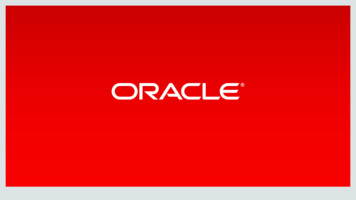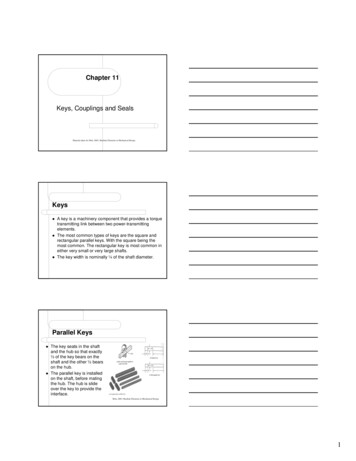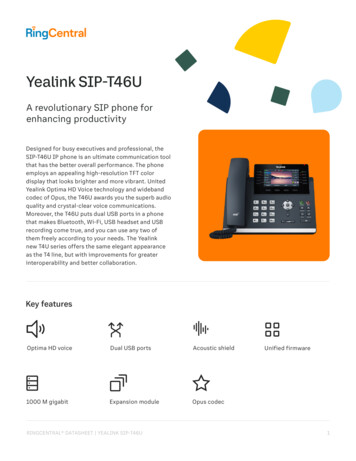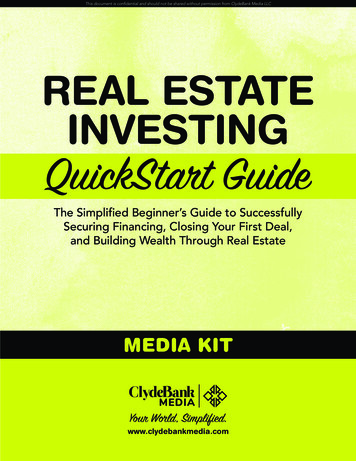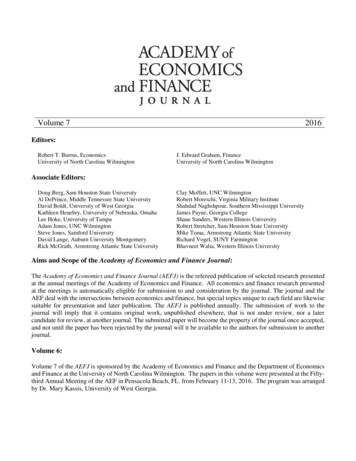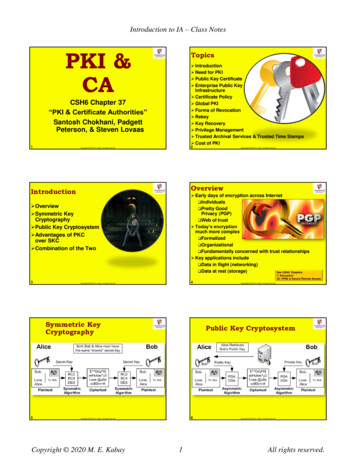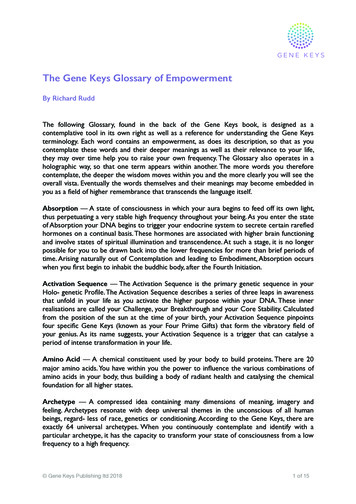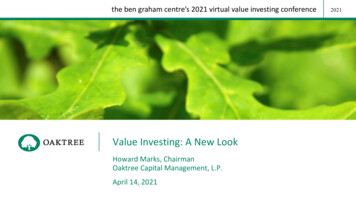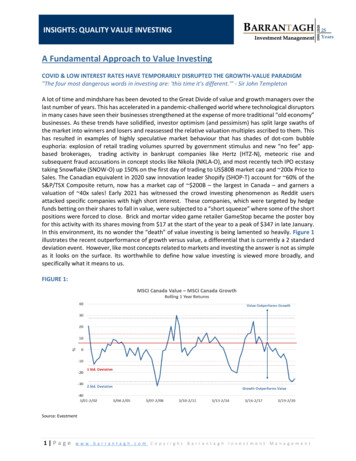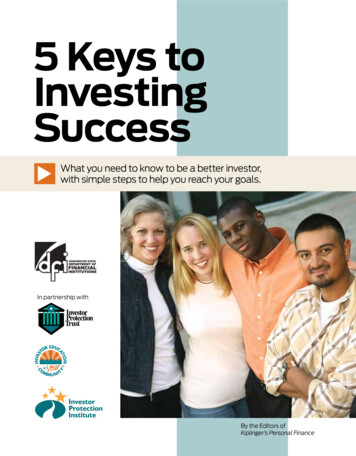
Transcription
5 Keys toInvestingSuccessWhat you need to know to be a better investor,with simple steps to help you reach your goals.In partnership withBy the Editors ofKiplinger’s Personal Finance
contentsTABLE OF CONTENTSAbout the Investor Protection TrustThe Investor Protection Trust1Key#1: Make investing a habit2Key#2: Set exciting goals3Key#3: Don’t take unnecessaryrisks(IPT) is a nonprofit organization devoted to investor edu-6Key#4: Keep time on your sidecation. More than half of all Americans are7Key#5: Diversifynow invested in the securities markets, making9Glossary of investing termsinvestor education and protection vitally important. Since 1993 the Investor ProtectionTrust has worked with the States and at thenational level to provide the independent,objective investor education needed by allAmericans to make informed investmentdecisions. For additional information, visitwww.investorprotection.org.About the Investor Protection InstituteThe Investor ProtectionInstitute (IPI) is an independent nonprofit organizationthat advances investor protection by conducting and supporting unbiased research andgroundbreaking education programs. IPIcarries out its mission through investor education, protection and research programs delivered at the national and grassroots level incollaboration with state securities regulatorsand other strategic partners. IPI is dedicatedto providing innovative investor protectionprograms that will make a meaningful difference in the financial lives of Americans in allwalks of life and at all levels of sophisticationabout financial matters. For additional information, visit www.iInvest.org.MONEYSMARTLIVINGPERSONALFINANCE 2015 by The Kiplinger Washington Editors Inc. All rights reserved.
Start by making investing a (good!) habitThe roller-coaster performance of the stock marketMeanwhile, your brother-in-law puts 5,000 in one-that accompanied the bursting of the housing andyear certificates of deposit (CDs) at the same bank,credit bubbles was a stark reminder of a fundamen-with instructions to roll over the proceeds into a newtal truth about investing: It involves risks. Still, invest-CD every 12 months. In addition, every month he buysing continues to offer the best means to achieve youra 100 CD and issues the same instructions. Over 20long-term goals. To be a successful investor meansyears he earns an average of 3.44% annually. His nestlearning to limit risks, not avoid them completely.egg: more than 44,000.Among investors who suffered most from the mar-That’s a lot better, but it’s not going to finance aket meltdown that began in 2007 are those whoworry-free retirement. Suppose your goal is to havebailed out and then missed the remarkable rally thata nest egg of 250,000. You’ve got 20 years to getfollowed. In the four years after the market hit athere and 5,000 to start. You’re willing to considerbear-market low in March 2009, stocks delivered ainvestments that should do better than a bank account.phenomenal average annual return of about 25%.What’s a reasonable return to plan on, and how muchAs you work to create an investing plan that suitsmore will you have to invest along the way?you, know that you can accumulate substantialsums of money by applying five keys to investmentthe magic of compoundingsuccess. These are keys, not secrets. In truth, thereare no investment secrets. This booklet presents abird’s-eye view of the methods employed by successful investors.Key #1: Make Investing a HabitThe best chance to acquire measurable wealth liesThink of compounding as asnowball growing as it rollsdown a hill. The longer the hill,the bigger the snowball. Thisgraphic shows how 5,000 willgrow over 20 years, dependingon whether additional amountsare regularly invested and therates of return on your depositsand reinvested earnings. 171,542in developing the habit of adding to your investmentsregularly and putting the money where it can do themost for you. The rewards can be considerable. Sup- 47,756 7,430pose you put 5,000 in a savings account where itearns a nice, safe, 2% rate of interest, compounded 5,000 at 2%,no additionalinvestments 5,000 at 4%, 100 investedeach month 5,000 at 8%, 250 investedeach monthannually. Twenty years later, you’ll have 7,430.1www.investorprotection.org
Exciting goals help you stay on trackSince 1926, the stocks of large companies have pro-Setting investment goals is a lot like reading a map:duced an average annual return of about 10%. (Re-Before you can get to where you want to go, you havemember, that includes such lows as the Great Depres-to figure out where you are. That’s the purpose of thesion, the stock slide that followed the September 11personal balance sheet on page 4. You may have to doterrorist attacks and the financial crisis of 2008.) If wea little guesstimating about the value of your furniture,assume a long-term annual return of 8%, you’ll needjewelry and so forth, but don’t spend a lot of time try-to add 382 a month to the initial 5,000 to reaching to be precise about those numbers. It’s the finan-your quarter-of-a-million-dollar goal in 20 years. If youcial portion of your balance sheet that should concerncan earn 10% annually, 279 a month will do the trick.you the most: money in savings accounts, stocks,These examples are simplified, of course, becausebonds, mutual funds, ETFs and real estate, for exam-they don’t take taxes or broker commissions intoaccount. But our point is simple, too: Making investinga habit is a key to making investing a success.Key #2: Set Exciting GoalsInvestment goal-setting is an intensely personalThere are no investmentsecrets. This bookletpresents a bird’s-eye viewof the well-known methodsused by successful investors.affair. But if you set generalized goals, such as “financial security” or “a comfortable retirement,” you’regoing to have trouble measuring progress along theple, plus what you have in a 401(k) or other companyway. You may even struggle to maintain interest in theretirement plan and your IRAs.project. Vaguely defined investment goals can lead tohalf-hearted efforts to achieve them.Better to set goals you can grab onto, goals thatexcite you. Instead of “financial security,” why notWhat you learn about where your money is willinfluence your goal-setting just as the amount of timeyou have to achieve your goals will influence the kindsof investments you consider.“ 500,000 net worth by age 60”? Instead of “a comfortable retirement,” why not “a portfolio that will yieldShort-term goals. Suppose that a vacation in Europe 2,000 a month to supplement my Social Security”?is one of your goals and that you would like to go nextNow those are real goals that you can put a price tagsummer. Such a short time horizon suggests that theon as an incentive to stick to your plan.stock market wouldn’t be a good place to invest the25 keys to investing success
to ride along if the market zooms, and reasonableprotection against a steep drop in stock prices.Long-term goals. A comfortable retirement is a near-universal financial goal. A college education for the kidsis another common aspiration. For long-term goals suchas these, you can afford to take more risk. Consider awide range of possibilities: stocks, corporate and government bonds, and long-term CDs for diversification.money you’re setting aside for the trip. The marketAlso take maximum advantage of tax-sheltered plans,is subject to wide swings, and you wouldn’t want tosuch as individual retirement accounts and 529 college-be forced to sell stocks in a downswing just becausesavings plans. Traditional IRA earnings accumulatethe time had come to buy your airline tickets. Don’t puttax-deferred, and contributions may be tax-deductible;any money into the stock market that you know youcontributions to Roth IRAs are never deductible, but allwill need in the next three to five years. Low-risk vehi-withdrawals in retirement can be tax-free. Company-cles, such as certificates of deposit that mature aboutsponsored 401(k) plans offer similar tax advantages andthe time you’ll need the cash, a money-market fund oroften include a real sweetener: matching contributionsan online bank account, may be a better choice.from your boss to help you reach your goal.Your goals are likely to change, so it’s important toMedium-term goals. Maybe you’d like to buy a housereassess them and your investment strategy annually.or move to a larger one within three or four years.The kinds of investments appropriate while you areWith more time, you have more flexibility. Safety is stillaccumulating a retirement nest egg could be inappro-important, but you are in a better position to ride outpriate after you retire. Luckily, there are plenty of re-bad times in the financial markets and take onsources—magazines, newspapers, books, the Internet,a little more risk. For medium-term goals, considerfinancial advisers—to help you decide how to modifylonger-term CDs that pay more interest. You couldyour portfolio as your circumstances change.even consider mutual funds that invest in stocks thatpay good dividends but don’t tend to fluctuate muchKey #3: Don’t Take Unnecessary Risksin price. That could give you higher income, a chanceMost people would say that risk is the chance you take3www.investorprotection.org
Where you stand now:Your personal balance sheetUse this worksheet to calculate your current assets, liabilities and net worth. When you know whereyour current net worth is coming from, you can see where your financial position is strong and where it isweak. This worksheet, along with the investment-mix worksheet on page 7, lays the necessary groundwork for setting your investment goals and making plans to reach them.HASSETSCash in savings accountsCash in checking accountsCash on handCertificates of depositMoney-market fundsU.S. savings bondsMarket value of homeMarket value of other real estateCash value of life insuranceSurrender value of annuitiesVested equity in pension plansVested equity in profit sharing401(k) or 403(b) plansIndividual retirement accountsKeogh plansStocksBondsStock mutual funds & ETFsBond mutual funds & ETFsReal estate investment trustsOther investmentsCollectibles Precious metalsEstimated market value of:Household furnishingsAutomobiles and trucksBoats, recreational vehiclesFurs and jewelryLoans owed to youOther assets (A)Total Liabilities (B)CURRENT NET WORTH(A minus B) Total AssetsGLIABILITIESBalance owed on mortgagesHome-equity credit line debtAuto loansStudent loansOther credit linesCredit-card billsOther debtthat you’ll lose all or part of the money you put into anchance you take that you will lose money or that yourinvestment. That’s true as far as it goes. But a moremoney will lose value.complete definition of risk acknowledges the availability of investments with virtually ironclad guaranteesHow can you control your risks? The pyramid is athat you will get all your money back plus the interestuseful visual image for a sensible risk-reducing strat-promised you—for instance, CDs in federally insuredegy. It’s built on a broad, solid base of financial secu-banks. Also, with all investments, you run the risk thatrity: your home and money in insured savings accountsyour return will be less than inflation. So, risk is theor CDs. As you move up from the base, the level of risk45 keys to investing success
Build your portfolio on a solid financial basegets higher, but so does the likelihood of higher re-One level up is the appropriate place for mutualturns. The greater the potential risk, the higher up thefunds or exchange-traded funds that invest in low-risk,pyramid the investment goes and the greater your po-dividend-oriented stocks and top-quality governmenttential reward.and corporate bonds. Individual stocks and bonds thatyou pick yourself are on the same level. Most financialHow much should you have in savings? Six months’experts would put investment real estate on the nextto a year’s worth of living expenses should be yourlevel up. At the very top of the pyramid go investmentsgoal. Banks and credit unions are good places to keepthat few people should try, such as penny or micro-this money, but look for opportunities to earn morecap stocks, precious metals, commodity futures andthan these institutions pay on run-of-the-mill depositmost limited partnerships.accounts—by putting most of it in CDs, for example.Check out what’s offered by online banks and money-How much risk should you take? Controlling riskmarket mutual funds, too.means more than being “comfortable” with an invest-Once you’ve built the base of your pyramid,you’re ready to move up and become an investor.ment. Too many investors seem perfectly comfortablewith too much risk. The basic thing to rememberabout risk is that it rises as the potential return in-The traditional risk pyramidcreases. The bigger the risk, the bigger the potentialpayoff. (Don’t forget that first p word, potential.) Or,speculativeturned around: The bigger the potential payoff, thebigger the risk of losing money.aggressive Growthlong-term growthDoes this mean you should avoid all high-riskinvestments? No. It means you should confine themto the top of the pyramid. Invest only as much as yougrowth and incomecan afford to lose because you might in fact lose it.cash, CDs,short-term u.s. debtYou should learn to recognize the risks involved inThe higher up the pyramid, the higher your potentialreward and the greater your risk of loss—andthe smaller the proportion of your investments.every kind of investment.Risks in stocks. A stock could decline because thecompany isn’t well managed or because its revenue5www.investorprotection.org
Recognize risks in every kind of investmentdeclines. Or a well-managed and prosperous compa-expects his or her pay to rise steadily over the yearsny’s stock could fall because investors sell millions ofand who has few family responsibilities can afford toshares of stock of all kinds (or stocks of a certain kind).take more chances than, say, a couple approachingThat’s what happened when the dot-com and creditretirement age. The young person has time to recoverbubbles burst. The entire market fell, without bother-from market reversals; the older couple may not.ing to differentiate good companies from bad.Key #4: Keep Time on Your SideRisks in bonds. As a general rule, bond prices moveA penny saved is a penny earned—or so the adageup when market interest rates fall and move downgoes. In fact, a penny saved may be more or less thanwhen interest rates rise. A bond paying 4% a year isa penny earned, depending on when it is earned andworth more if prevailing rates fall to 3%, for example,how it is saved. The reason is rooted in a conceptand drops in value if newly issued bonds are payingcalled the time value of money and its close cousin,5%. But individual bond issues can be hurt even ifopportunity cost.rates in general are falling because a rating serviceWhich would you rather have, 10,000 today ordowngrades its opinion of the company’s stability.A bond paying a noticeably higher rate than bondshow to diversifywith similar maturity dates is probably paying moreto compensate investors for higher risk.Risks everywhere. Real estate values generally go80%50%40%up and down in sync with supply and demand in local20%markets, regardless of the health of the national econ-25%10%omy. Gold and silver, which are supposed to shine ininflationary times, have usually been decidedly unrewarding in times of tolerable inflation.What is a prudent risk? That depends on your goals,your age, your income and other resources, and yourfinancial obligations. A young single person who65 keys to investing successstocksbondscashThink in terms of ranges rather than fixed percentages when deciding how to divvy up your investments. A diverse portfolio allows you to managerisk and adjust according to the market and yourtime horizon.
q 10,000 a year from today? Of course, you’d take therebalance yourinvestmentsmoney now. Not only is a bird in the hand worth twoin the bush, but 10,000 will be worth less a yearfrom now due to the effects of inflation. And delayingComplete this worksheet at least once a year soyou’ll know how your investment mix is changing. Then take action to bring it back into linewith a mix that matches your goals and your risktolerance.Marketvaluepercentof totalCashwould cost you a year’s worth of earnings.Failing to understand how the time value of moneyworks can cause you to think that you’re doing something smart when you may not be. For instance, youmay have heard praises sung for the 15-year mortgage. Because you pay it off sooner than a 30-yearSavings accounts & CDs %Money-market funds %Treasury bills %TOTAL CASH %loan, you pay less interest and save thousands of dollars. But the homeowner with the 15-year mortgageparts with the money sooner. Here’s where opportunity cost—the cost of doing one thing and not an-Stocksother—comes into play.Individual shares %Mutual funds & ETFs %TOTAL STOCKS %BondsWhat else might you do with the money you’dspend on the higher monthly payments on the 15-yearmortgage? If you could invest it at a higher rate of return than the mortgage rate, you’d actually come outIndividual bonds %Mutual funds & ETFs %TOTAL BONDS %Rental real estate %Limited partnerships %Precious metals %Collectibles %Other investments %TOTAL INVESTMENTS 100 %ahead. Of course, the reward of not paying interest isguaranteed, while what you could earn on alternativeinvestments is not. You need to weigh the potentialrisk and reward of both strategies.Key #5: DiversifySimply put, diversifying means not putting all your investment eggs in one basket. No investment performswell all the time; when one thing is down, anotherthing tends to be up. By spreading your investments7www.investorprotection.org
Rebalancing lets you sell high and buy lowstate securitiesregulatorsaround, you’re likely to increase your overall return andreduce your risk at the same time.Some investors diversify by selecting a number ofinvestments and dividing their money equally amongState Securities Regulators have protected investors from fraud for more than 100 years. Securitiesmarkets are global, but securities are sold locallyby professionals who are licensed in every statewhere they conduct business. State Securitiesthem. Once a year, they adjust the mix to maintain thedollar balance, taking the gains from the winners andspreading them among the losers. Although it mightsound crazy to sell some of the best performing in-Regulators work within your state government tovestments to invest in the laggards, think of it as sell-protect investors and help maintain the integritying high and buying low.of the securities industry.But diversifying doesn’t mean buying equal chunksof everything. It’s more realistic to think in terms ofYour State Securities Regulator can:n Verify that a broker-dealer or investmentadviser is properly licensed;n Provide information about prior run-ins withregulators that led to disciplinary or enforcementactions; serious complaints that may have beenranges. For example, perhaps stocks should make up50% to 80% of your portfolio, bonds 20% to 40%and cash 10% to 25%. A model portfolio is intendednot as a hard-and-fast formula but as guidance forconstantly changing investment markets. Your mixlodged against them; their educational back-should also take into account your age, income andground and previous work history;investment goals.n Provide a Web site, telephone number orAnother thing about the model portfolio: Stocksaddress where you can file a complaint; anddoesn’t necessarily mean individual shares. Nor doesn Provide noncommercial investor education andbonds mean individual issues. Mutual funds or ex-protection materials.change-traded funds are often the best way to ownFor contact information for your State SecuritiesRegulator, visit the North American SecuritiesAdministrators Association (NASAA) Web siteat www.nasaa.org and click on “Contact YourRegulator.”stocks and bonds.Wrap up. As noted earlier, these keys are not secrets.Nor are they guarantees. But if you pay attention tothem as you make investment decisions, you’re morelikely to achieve your goals. n85 keys to investing success
glossaryBond. An interest-bearing security that obligates the issuer toretirement plan at work. Earnings grow tax-deferred, and with-pay a specified amount of interest for a specified time (usuallydrawals are taxable. Contributions to a Roth IRA are neverseveral years) and then repay the bondholder the face amountdeductible, but earnings accumulate tax-free and withdrawalsof the bond.are tax-free in retirement.Capital gain (or loss). The difference between the price at whichMoney-market fund. A mutual fund that invests in short-termyou buy an investment and the price at which you sell it.corporate and government debt and passes the interest pay-Central Registration Depository (CRD). A computerizedments on to shareholders.database that contains information about most brokers, theirMutual fund. A professionally managed portfolio of stocks,representatives and the firms they work for.bonds or other investments divided up into shares.Certificate of deposit. Usually called a CD, a certificate ofOpportunity cost. The cost of passing up one investment indeposit is a short- to medium-term instrument (one month tofavor of another.five years) issued by a bank or credit union to pay interest at arate higher than that paid by a regular savings account.Compound interest. This is really interest paid on interest.When interest is earned on an investment and added to theoriginal amount of the investment, future interest paymentsare calculated on the new, higher balance.Diversification. The method of balancing risk by investing in avariety of securities.Dividends. The portion of company earnings that are paid outto stockholders.Portfolio. The collection of all of your investments.Prospectus. The document that describes a securities offeringor the operations of a mutual fund, a limited partnership orother investment.Risk tolerance. Risk tolerance is the degree to which you arewilling to risk losing some (or all) of your original investment inexchange for a chance to earn a higher rate of return. In general,the greater the potential gain from an investment, the greaterthe risk that you might lose money.State Securities Regulators. Agencies that work within stateExchange-traded funds (ETFs). Mutual funds that trade likegovernments to protect investors and help maintain the integ-stocks on the exchanges. An ETF’s portfolio represents a slicerity of the securities industry.of the market—an index, a subsector of an index or a particularindustry.Stock. A share of stock represents ownership in the companythat issues it. The price of the stock goes up and down, depend-401(k) plan. An employer-sponsored retirement plan thating on how the company performs and how investors think thepermits employees to divert part of their pay tax-free intocompany will perform in the future.the plan. Money invested in the 401(k) may be matched by theemployer, and earnings accumulate tax-deferred until they’rewithdrawn.Home equity. The difference between the market value of ahome and the outstanding balance on the mortgage and anyhome-equity line of credit.Time value of money. The concept that money today is worthmore than the same amount in the future, when inflation hasreduced its value.Total return. An investment-performance measure that combines two components: any change in the price of the sharesand any dividends or other distributions paid to shareholdersIndividual retirement account (IRA). A tax-favored retirementover the period being measured. With mutual funds, total-returnplan. Contributions to a traditional IRA may be tax-deductible,figures assume that dividends and capital-gains distributionsdepending on your income and whether you are covered by aare reinvested in the fund.9www.investorprotection.org
where to find morefree information about investingThe following booklets from the Editors of Kiplinger’s Personal Finance magazine and the InvestorProtection Trust are available at your library and offices of State Securities Regulators.Five Keys to Investing SuccessGetting Help With Your InvestmentsMake investing a habitSet exciting goalsDon’t take unnecessary risksKeep time on your sideDiversifyDo you need a financial adviser?Who’s who among financial advisersHow to choose an adviser5 questions to ask before you hire an adviserHow to open an accountWhat can go wrongHow to complainThe Basics for Investing in StocksDifferent flavors of stocksThe importance of diversificationHow to pick and purchase stocksKey measures of value and finding growthWhen to sellWhat’s your return?Consider mutual fundsA Primer for Investing in BondsHow do bonds work, anyway?How much does a bond really pay?How to reduce the risks in bondsGoing the mutual fund routeMaximize Your Retirement InvestmentsThree key rulesCreating the right investment mixGuidelines for saving at every life stageInvesting on targetBest places to saveGetting the money outCreating an income streamProtect your money: Check out a broker or adviserWhere to Invest Your College MoneyMutual Funds and ETFs:Maybe All You’ll Ever NeedMutual funds: The best investmentThe different types of fundsHow to choose funds and assemble a portfolioSources of mutual fund informationWhere to buy fundsThe basics of investing for collegeInvesting in a 529 savings planLocking in tuition with a prepaid planOther tax-favored ways to saveTax credits for higher educationSave in your child’s name?MONEYSMARTLIVINGPERSONAL1020 19th Street NW, Suite 890 Washington, DC 20036www.investorprotection.orgFINANCE1100 13th Street NWWashington, DC 20005www.kiplinger.comA variety of noncommercial investor education and protection materials, including booklets, videos and curricula, are available and can be downloaded for educationalpurposes at www.investorprotection.org and www.iInvest.org.
5 KeyS to InveStIng SucceSS chance you take that you will lose money or that your money will lose value. How can you control your risks? the pyramid is a useful visual image for a sensible risk-reducing strat-egy. It's built on a broad, solid base of financial secu - rity: your home and money in insured savings accounts or cDs.
